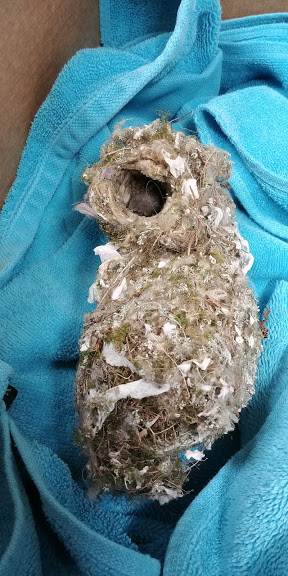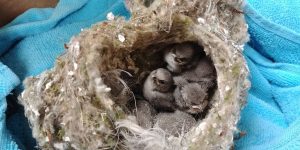Support Us
Since 1979 more than 140,000 animals have been treated by Wildlife Rescue.
Thanks to the support of individuals like you, Wildlife Rescue can provide a lifeline for animals in distress.
Bushtits are lively social songbirds that can be seen flying between shrub and thickets in Western North America with their plump tiny body, a large head, and short stubby bills. One can identify them by their plain brown and gray color and twittering calls that can be heard if you pay close attention. Bushtits travel in flocks and sometimes mix with smaller songbirds like warblers, chickadees, and kinglets.
Bushtits seek homes in oak forests, evergreen woodland, dry scrublands, stream sides, and suburban areas. No wonder they enjoy British Columbia year-round! When staking out nesting areas, they fend off spiders and small insects that adhere to leaves and twigs as well as plant-feeding bugs including beetles, caterpillars, and wasps.

A unique nesting dynamic sets bushtit apart from other songbird species. They are the only species that build a hanging nest. Breeding pairs stay together for at least two years and explore several nest sites. Nest site by hanging their spiderweb-like nest from mistletoe and other similar vegetation. Nest sites tend to be on branches or trunks of trees. The nest hangs approximately a foot below its anchor point with a small hole near the top that leads into the nest bowl like a pouch or a sock. To keep the nest insulated bushtits, use feather, fur, downy and plant materials. Bushtits can have a clutch size of 10-14 eggs and 1-2 broods per year. They are fed and brooded by both parents and surprisingly the parents have helpers who are typically other colony males to help raise the nestlings. The young leave the nest 14-15 days after hatching.
Bushtits are easy-going when it comes to their nest. Unlike some species who hiss or become aggressive at potential threats, bushtits tend to allow others to get close to their nest. Sometime this easy-going attitude might lead predators to steal from their well-built nest, but the parents do a good job of keeping an eye on their young.
This relaxed attitude of the bushtits and heroic residents from a local community in East Vancouver, BC helped Wildlife Rescue reunite a fallen nest back to its parents within 24 hours.
A concerned family brought a bushtit nest to Wildlife Rescue hospital after the nest had fallen onto the ground from a large tree trunk at the front of their property. The family was worried that the fall might have injured the nestlings inside. Our team knew the nestlings needed to be reunited with their parents within 24 hours to ensure survival.

Staff weaved the nest back together using twine and similar material that the bushtits would use and provided healthy nutrition overnight. The staff and volunteers were optimistic about reuniting them with their parents and headed back to the location of the finder in less than 12 hours!
The outcome was nothing short of a miracle! As soon as the new nest was placed back in the tree trunk, the parents were present and ready to feed their young ones ensuring survival for these nestlings was possible.
When good Samaritans and caring members of communities come to find injured, orphaned or displaced wildlife you provide hope and another chance for survival to these vulnerable animals. The relationship between you and Wildlife Rescue is vital and helps our ecosystem thrive. You give wildlife a second chance!

If you have any questions or concerns about wildlife, please read our website or email info@wildliferescue.ca or call Wildlife Support Centre at 604-526-7275 so we can help you assess the situation for the care needed.